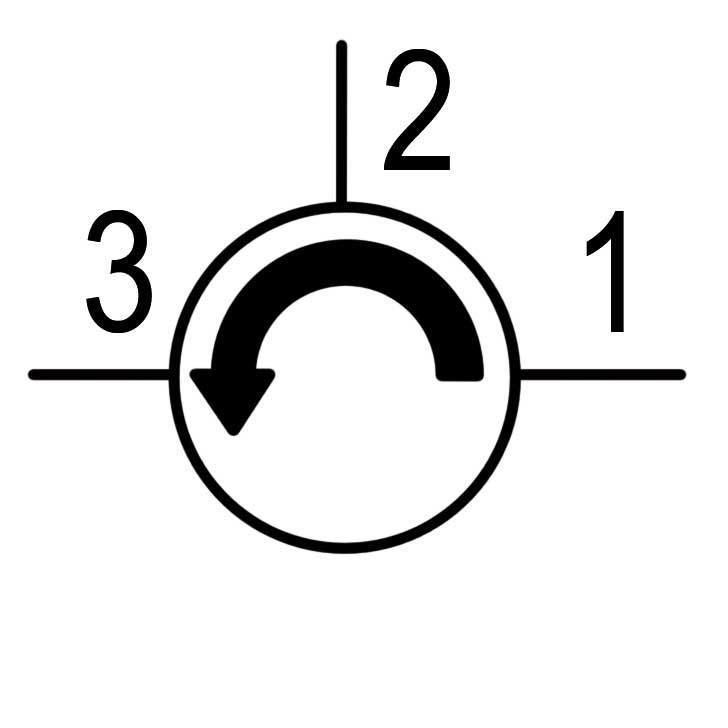 | ||
A circulator is a passive non-reciprocal three- or four-port device, in which a microwave or radio frequency signal entering any port is transmitted to the next port in rotation (only). A port in this context is a point where an external waveguide or transmission line (such as a microstrip line or a coaxial cable), connects to the device. For a three-port circulator, a signal applied to port 1 only comes out of port 2; a signal applied to port 2 only comes out of port 3; a signal applied to port 3 only comes out of port 1, so to within a phase-factor, the scattering matrix for an ideal three-port circulator is
Contents
Types
Depending on the materials involved, circulators fall into two main categories: ferrite circulators and nonferrite circulators.
Ferrite
Ferrite circulators are radio frequency circulators which are composed of magnetised ferrite materials. They fall into two main classes: 4-port waveguide circulators based on Faraday rotation of waves propagating in a magnetised material, and 3-port "Y-junction" circulators based on cancellation of waves propagating over two different paths near a magnetised material. Waveguide circulators may be of either type, while more compact devices based on stripline are of the 3-port type. Two or more Y-junctions can be combined in a single component to give four or more ports, but these differ in behaviour from a true 4-port circulator. A permanent magnet produces the magnetic flux through the waveguide. Ferrimagnetic garnet crystal is used in optical circulators.
Though ferrite circulators can provide good 'forward' signal circulation while suppressing greatly the 'reverse' circulation, their major shortcomings, especially at low frequencies, are the bulky sizes and the narrow bandwidths.
Nonferrite
Early work on nonferrite circulators includes active circulators using transistors that are non-reciprocal in nature. In contrast to ferrite circulators which are passive devices, active circulators require power. Major issues associated with transistor-based active circulators are the power limitation and the signal-to-noise degradation, which are critical when it is used as a duplexer for sustaining the strong transmit power and clean reception of the signal from the antenna.
Varactors offer one solution. One study employed a structure similar to a time-varying transmission line with the effective nonreciprocity triggered by a one-direction propagating carrier pump. This is like an AC-powered active circulator. The research claimed to be able to achieve positive gain and low noise for receiving path and broadband nonreciprocity. Another study used resonance with nonreciprocity triggered by angular-momentum biasing, which more closely mimics the way that signals passively circulate in a ferrite circulator.
In April, 2016 a research team presented an integrated circuit circulator based on N-path filter concepts. It offers the potential for full duplex communication (transmitting and receiving at the same time with a single shared antenna over a single frequency). The device uses capacitors and a clock and is much smaller than conventional devices.
Isolator
When one port of a three-port circulator is terminated in a matched load, it can be used as an isolator, since a signal can travel in only one direction between the remaining ports. An isolator is used to shield equipment on its input side from the effects of conditions on its output side; for example, to prevent a microwave source being detuned by a mismatched load.
Duplexer
In radar, circulators are used as a type of duplexer, to route signals from the transmitter to the antenna and from the antenna to the receiver, without allowing signals to pass directly from transmitter to receiver. The alternative type of duplexer is a transmit-receive switch (TR switch) that alternates between connecting the antenna to the transmitter and to the receiver. The use of chirped pulses and a high dynamic range may lead to temporal overlap of the sent and received pulses, however, requiring a circulator for this function.
In the future-generation cellular communication, people talk about full-duplex radios, where signals can be simultaneously transmitted and received at the same frequency. Given the currently limited, crowded spectrum resource, full-duplexing can directly benefit the wireless communication by twice of the data throughput speed. Currently, the wireless communication is still performed with "half-duplex", where either the signals are transmitted or received at different time frames, if at the same frequency (typically in radar), or the signals are simultaneously transmitted and received at different frequencies (realized by a set of filters called a diplexer).
Reflection amplifier
A reflection amplifier is a type of microwave amplifier circuit utilizing negative differential resistance diodes such as tunnel diodes and Gunn diodes. Negative differential resistance diodes can amplify signals, and often perform better at microwave frequencies than two-port devices. However, since the diode is a one-port (two terminal) device, a nonreciprocal component is needed to separate the outgoing amplified signal from the incoming input signal. By using a 3-port circulator with the signal input connected to one port, the biased diode connected to a second, and the output load connected to the third, the output and input can be uncoupled.
